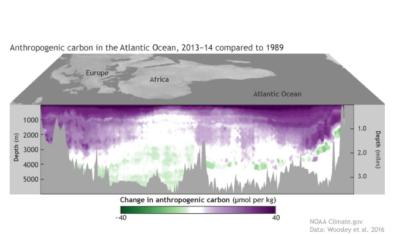Science Source
Using present-day observations to detect when anthropogenic change forces surface ocean carbonate chemistry outside preindustrial bounds
- States that one of the major challenges to assessing the impact of ocean acidification on marine life is detecting and interpreting long-term change in the context of natural variability
- This study addresses this need through a global synthesis of monthly pH and aragonite saturation state (Ωarag) climatologies for 12 open ocean, coastal, and coral reef locations using 3-hourly moored observations of surface seawater partial pressure of CO2 and pH collected together since as early as 2010
- Mooring observations suggest open ocean subtropical and subarctic sites experience present-day surface pH and Ωarag conditions outside the bounds of preindustrial variability throughout most, if not all, of the year
- States that in general, coastal mooring sites experience more natural variability and thus, more overlap with preindustrial conditions; however, present-day Ωarag conditions surpass biologically relevant thresholds associated with ocean acidification impacts on Mytilus californianus (Ωarag < 1.8) and Crassostrea gigas (Ωarag < 2.0) larvae in the California Current Ecosystem (CCE) and Mya arenaria larvae in the Gulf of Maine (Ωarag < 1.6)
- Concludes that further improving experimental design to interrogate organism response under real-world conditions, and improving predictive models and vulnerability assessments seeking to quantify the broader impacts of ocean acidification
Related Content
Headline

Jun 6, 2018 | NOAA Climate.gov
Cruises cut a slice through the Atlantic's carbon pie
Science Source
| Nature Climate Change
Detecting regional anthropogenic trends in ocean acidification against natural variability
T. Friedrich, A. Timmermann, A. Abe-Ouchi et al
Science Source
| Estuaries and Coasts
Is Ocean Acidification an Open-Ocean Syndrome? Understanding Anthropogenic Impacts on Seawater pH
Carlos M. Duarte, Iris E. Hendriks, Tommy S. Moore et al
Science Source
| Proceedings of the National Academy of Sciences
Ocean acidification affects coral growth by reducing skeletal density
Nathaniel R. Mollica, Weifu Guo, Anne L. Cohen et al


